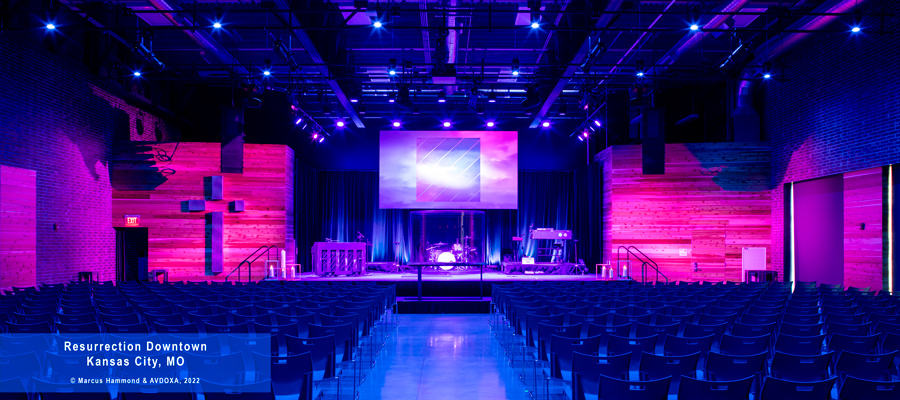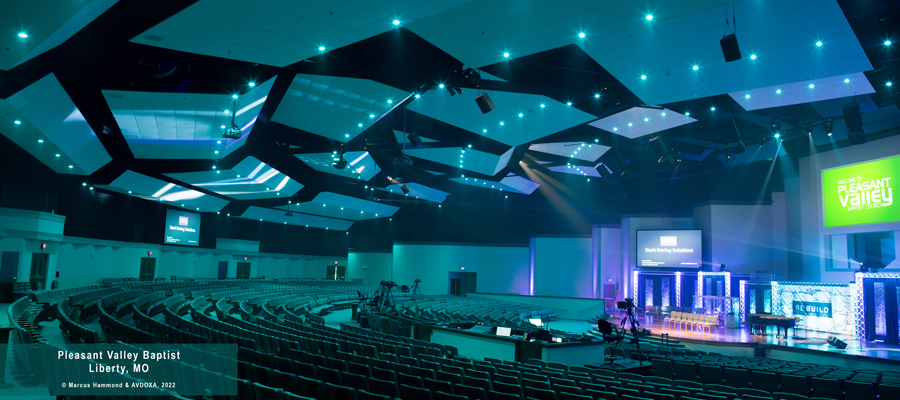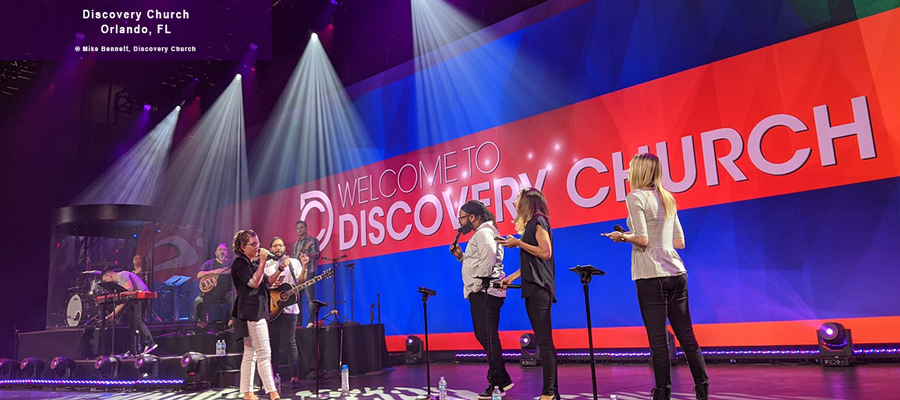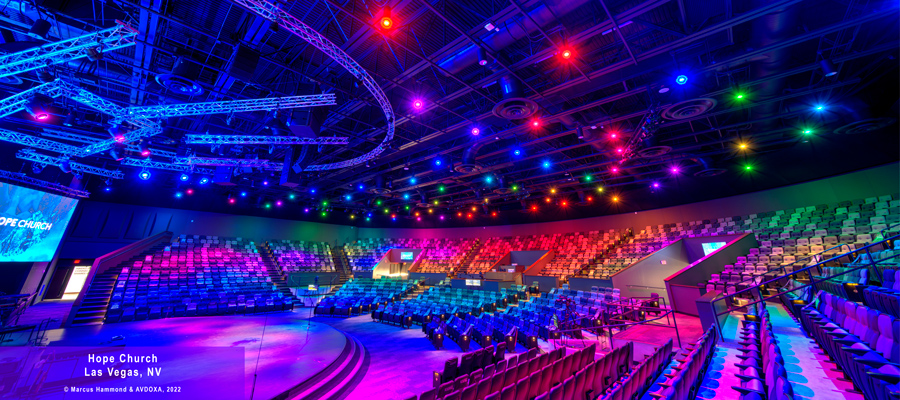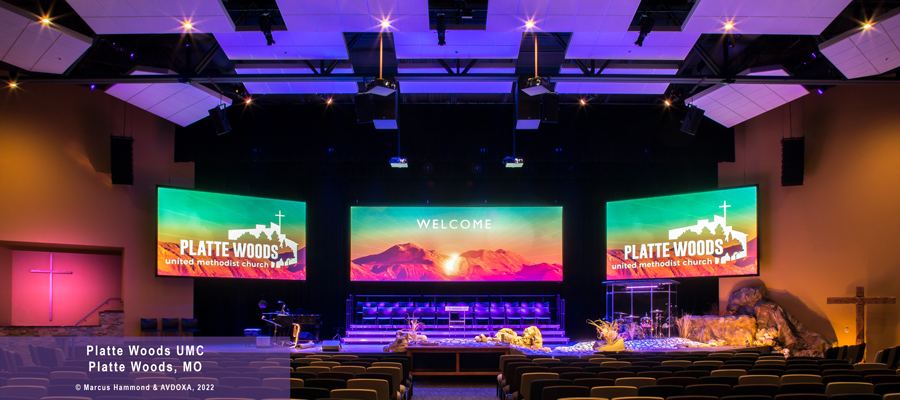Are you sure you want to perform this action?

Five Benefits of Immersive Color in House of Worship Environments
February 9, 2023 08:00
Introduction
Color plays an important role in human cognition, as artists have recognized it for thousands of years. It can also be a valuable tool in houses of worship. It can help capture and direct people’s attention, raise the energy level in a space, make it more aesthetically appealing, create or enhance the mood, and more.
One of the most important developments in the use of color was when Johannes Itten, a painter, and teacher at the Bauhaus school, codified what great artists intuitively understand about color in his book “The Art of Color,” written in 1920. In it, he describes a color wheel with 12 colors (yellow, yellow-orange, orange, red-orange, red, red-violet, violet, blue-violet, blue, blue-green, green, and green-yellow) and he identified seven types of color contrast, including contrast by hue or color, contrast by value or the lightness or darkness of a color, contrast by color temperature, contrast by complements, simultaneous contrast, contrast by saturation, and contrast by extension. These color combinations are pleasing to the eye and work well together.
Color and color combinations can evoke strong emotions. A natural response to red is an increase in appetite or energy, while green is very calming and soothing. And how can one see a combination of red and green and not think of Christmas? The emotional reaction to colored light and the seven types of contrasts can be a great starting point for designing lighting looks in houses of worship. Here are five ways to use color and light to enhance the churchgoer’s experience in houses of worship.
5 Benefits of Immersive Color in a House of Worship:
- Storytelling
- Experiential and Emotionally Connective Music
- Non-Church-Related Events
- Color is the New Stained Glass
- Bi-directional Engagement
Join our community to continue to learn about how A.C. Lighting can assist you in your House of Worship lighting design. You can also request a meeting or demo while filling out this form. We would be happy to answer any of your questions or provide you with a personal demo of our product lines.
#1 - Storytelling – The Spoken Word
Creating a uniform wash of tunable white light across a large platform that is accurately repeatable is very important for focusing attention on the platform in houses of worship. Tunable white light helps to ensure that skin tones and set pieces are rendered naturally regardless of the complexion of the subject(s) or the colors of the set. White light can range in color temperature, color rendering index (CRI), R9 value (an extended measure of color rendering), TM-30 value (an even more extended measure of color rendering), and in its television lighting consistency index (TLCI), which is a measure of how faithfully a light source renders colors and skin tones on video. White light with low color temperature, which is what is produced by tungsten lamps, ranges from about 3000 Kelvin (K) to about 3200 K. White light with high color temperature can range from about 5600 K to about 8000 K, which is what daylight looks like with a clear blue sky when the sun is at its highest point in the daylight sky. Tunable white light can be adjusted to match the desired color temperature.
Lighting designers might choose to light a subject with a lower color temperature for front light to bring out the red in skin tones and a higher color temperature for backlight to create a contrast that emphasizes the depth or modeling of a subject. At times, a lighting designer might use a value in between tungsten and daylight, or around 4500 K, for front light, especially if there is a mix of light sources with different color temperatures in the same lighting rig.
Luminaires with a high color rendering index (CRI), TM-30, and a high TLCI are great tools for lighting a subject for the camera because they make colors look “right” on camera. Another important consideration is that the white light produced by a fixture is balanced between green and magenta so that skin tones look natural. Some fixtures have a +/- green shift setting in the menuing structure, which allows you to compensate for an uncalibrated camera or another light source that might be polluting the subject. One such fixture is the PROLIGHTS EclPanel TWC. It is also useful for creating a uniform wash because it has a wide field angle of 159ᴼ, which is especially important for video. After all, the camera is much more sensitive to hot spots and cold spots than the human eye.
Fixtures like the EclProfile CT+ from PROLIGHTS that can output high CRI, high R9, and high TLCI are great for front lighting a subject while also allowing the designer or operator to add dramatic color. For lighting the sanctuary with white light or colored light, consider the Chroma-Q Inspire, Mini, and XT.
#2 - Experiential and Emotionally Connective Music
Music evokes emotion, and lighting can enhance or heighten the visceral response to music. This is one area where color theory can help. Color can be used to symbolize a “mood” or an emotion by washing the platform with saturated color or color combinations. Red is often associated with high energy (like a red sports car), excitement, or love. Green can be a calming color (think of a forest) or it can represent money or good health. Blue is an appealing color, and it probably has the widest spectrum, although the camera sometimes has difficulty reproducing subtle shades of blue. Yellow is the happiest and brightest color, and violet can evoke strong emotions. With a little research and experimentation, you can learn how certain colors affect the feel of a space.
As a starting point to experiment with color combinations, the color wheel provides a good tool to explore the seven contrasts. Starting at any point on the color wheel, combining it with the color on the opposite side of the wheel creates a contrast of complements. For example, medium blue and bright yellow create a strong contrast with a lot of tension, yet, for most people, it is a very pleasing look. Combining colors closer to each other on the color wheel can create less contrast and combining adjacent colors on the color wheel (analogous colors) creates simple color harmony. Combining three colors equidistant from each other on the color wheel creates a color triad and it can be visually pleasing and balanced. Several other color combinations can be discovered by taking a deeper dive into the seven contrasts.
To create looks with saturated color, a LED wash fixture like the Chroma-Q Color One 100X LED PAR is a powerful tool. It outputs 1,950 lumens of saturated or pastel colors using an RGBA LED light engine. It has a 19ᴼ beam angle and the optics are homogenized so that it produces clean shadows with no color separation.
For more dynamic and temporal looks, special effects, patterns, and movement can also be incorporated to raise the energy level or create flow in a music environment. Fixtures like the PROLIGHTS PixieWash XB or JetSpot 4Z offer rich, saturated color and, in addition to crossfading and pulsing effects, they also can pan, tilt, zoom, and strobe to add dynamic looks and beam movement.
#3 - Non-Church-Related Events
Hosting community events outside of normal church activities is a good way to raise your profile in the community and increase traffic through your facilities. Events like holiday celebrations, fall and spring festivals, clothes drives, blood drives, public school events, and carnivals help to build a bridge to the community and grow your congregation. Color-changing lights can be used to highlight these events, drawing attention to the space, and help to reinforce a theme such as using patriotic red, white, and blue colors for the Fourth of July or for hosting public elections. Weddings, funerals, retirement parties, or other celebrations can also benefit from splashes of beautiful color accents or a color wash to completely transform a space.
Using colored light can be very cost-effective as well and using LED color makes it very easy to transform with the push of a button or the click of a mouse to suit the occasion. Whether it calls for Christmas colors or an Easter sunrise, fixtures like the Chroma-Q Color Force II 12, 48, and 72, and the PROLIGHTS EclCyclorama 100 can be used to wash large swaths of surface area in environments that are protected from the elements, and the EclProfile FS can provide image projection as well as color light projection. For lighting large surfaces, walls, softgoods like drops and curtains, LED color wash fixtures like the Chroma-Q Color One 100X can provide a wide gamut of saturated and pastel colors.
Learn more about Discovery Church and how they used PROLIGHTS, Chroma-Q, Vista by Chroma-Q, and Luminex products in their lighting design.
#4 - Color is the New Stained Glass
Stained glass is a classic means of telling a story or depicting a scene. One of the most breathtaking examples is in Barcelona, Spain, at the Basílica de la Sagrada Familia designed by Antoni Gaudi in 1883. On a clear day, sunlight enters the cathedral at varying angles through numerous panes of perfectly placed colorized stained glass, washing the entire Nave in a rich, saturated color for a period of time. As beautiful as stained glass can be, it relies on natural sunlight for illumination, which yields varying results. On clear, bright days when the sun is high in the sky, the colors of the stained glass can be magnificent, but on overcast days and at night, they are less spectacular. Supplementing natural light with artificial backlight ensures that the beauty of the stained glass is always available regardless of environmental conditions. Fixtures like the Chroma-Q Color Force II 12, 48, and 72, and the Chroma-Q Inspire are ideal for washing large surfaces with colored or white light.
It’s also possible to re-create the look of stained glass without the costly colored glass by using projection and colored gobos. PROLIGHTS EclProfile FS fixtures are available with HQ glass lens tubes in 14ᴼ, 19ᴼ, 26ᴼ, 36ᴼ, and 50ᴼ, and high-resolution dichroic gobos can be inserted in the gate to project beautiful images of stained glass. An EclProfile FS with a 14ᴼ HQ glass lens tube produces a 10-foot image at a throw of about 40 feet, while a fixture with a 50ᴼ HQ glass lens tube produces a 7-foot image with a throw of about 12 feet.
As early as the 19th century and before, artists and architects like Gaudi knew that abstract, immersive color could beautifully tell a story and create an engaging environment in the sanctuary for centuries to come. With today’s LED tools, we can now tell the story using color-changing light and projection at the push of a button. We can create an environment that connects people to the space and to a story using lighting technology that is convenient and effective.
#5 Bi-directional Engagement
A church service that invites active participation rather than passive observation and envelops the congregation in a community is much more engaging and energizing. Colored, dynamic lighting in the sanctuary can create an inviting space and an immersive environment that helps unify the audience and the worship leaders, and it can extend the look and feel from the platform into the house.
Starting before the service, a brightly lit and colorful walk-in look can help welcome and usher in attendees upon arrival and signal transitions in the service or signal the end of a service. Special occasions and holidays can also be recognized with the appropriate colors. Color accents can help create an aesthetically pleasing environment for worship.
Some white light LED fixtures also can change color, and having the ability to immerse the sanctuary in saturated color can help set the mood for the delivery of a message or praise and worship. It can allow the pastor to tell a story more engagingly and it can help engross the congregation, set the mood, and capture their attention. Some of these luminaires use a simple combination of red, green, and blue LEDs to produce white light and colored light. These fixtures typically do not render white light or colors well. Other fixtures use a combination of red, green, blue, deep blue (or royal blue), mint, and amber LEDs to better cover the color spectrum. These fixtures tend to render white light and colors much better.
Whether it is more subtle or drastic, color-changing house lights can heighten the experience and enliven the mood in the sanctuary. The Chroma-Q Inspire, including the Inspire Mini and Inspire XT are great tools for creating energy and extending it from the platform into the house using white or color-changing LED lighting.
We hope you have enjoyed this learning series on the Five Benefits of Immersive Color in House of Worship Environments.
https://bit.ly/3YwNjzh Join our community to continue to learn about how A.C. Lighting can assist you in your House of Worship lighting design. You can also request a meeting or demo while filling out this form. We would be happy to answer any of your questions or provide you with a personal demo of our product lines.
Images: © Marcus Hammond, AVDOXA, 2022; © Mike Bennett, Discovery Church
Don’t forget to follow A.C. Lighting on Social Media:
About A.C. Lighting, Inc.
A.C. Lighting, Inc. is a value-added distributor of world-class lighting and associated rigging technologies for the theater, film, television, worship, exhibition, and commercial markets. A.C. Lighting a North American distributor for premier brands including Chroma-Q® LED lighting, Vista by Chroma-Q lighting and media control surfaces, PROLIGHTS high value and high-performance range of lighting, video and effects products, Luminex Networking Intelligence manufacturer of data distribution equipment, Manfrotto and Avenger: Professional Lighting Stands and Accessories, Follow-Me Remote Follow Spot Control Systems, LumenRadio wireless lighting controls, and Prolyte staging and trussing.
For more information, please visit www.aclighting.com or call 416.255.9494
About PROLIGHTS
PROLIGHTS is the professional lighting division of Music & Lights S.r.l., an Italian company specialized in the manufacture of technologies for the show industry.
The PROLIGHTS brand was established in 2001 with a focus on the design and manufacture of professional lighting & video products for the entertainment, event, broadcast, and installation markets.
PROLIGHTS is headquartered in Minturno, Italy, where the company's commercial, operational, and R&D centres are all located.
PROLIGHTS continues to experience sustained growth across all sectors, with its products found on stages and in studios all over the world. Founder Franco Sorabella, and his son Fabio, are both actively involved in the day-to-day running of the business and in the development of the product range.
For more information, please visit www.aclighting.com/prolights-lighting or call 416.255.9494
About Chroma-Q
Chroma-Q and all associated product names are recognised trademarks, for more information visit www.chroma-q.com/trademarks. The rights and ownership of all trademarks are recognised. Whilst every effort has been made to ensure that the information is correct, Chroma-Q accepts no liability for errors or omissions. Technical specifications and data are provided for guidance only. Because we constantly aim to improve our products, we reserve the right to amend or alter at any time and without prior notice, the specifications of any product. E&OE.
Editor’s note:
Chroma-Q® have been designing lighting equipment for over 25 years, with a reputation for high product quality, innovation and reliability.
Today, LED based lighting products are the core of Chroma-Q’s portfolio.
Chroma-Q have gained a reputation for introducing award-winning, premium LED lighting solutions which deliver the highest performance levels required by today's most demanding applications - including concerts & theatre shows, film & TV broadcasts, retail, leisure & museum installations, exhibitions & corporate hospitality events.
Follow Chroma-Q on Social Media:
www.facebook.com/chromaq.lighting
Please visit www.chroma-q.com for more information and a full list of Chroma-Q dealers.
ABOUT LUMINEX NETWORK INTELLIGENCE
Luminex Network Intelligence is a Belgian-based manufacturer of data distribution equipment for professional lighting, audio, and video applications. Luminex enables AV professionals in the entertainment industry to use the latest technology confidently. Luminex offers a complete range of network switches, converters/nodes, and DMX splitters, providing AV designers and technicians with cutting-edge technology to build a complete data distribution system from small to large events or venues. Luminex commits to making it as easy as possible to deploy a professional AV network, even without IT knowledge.
Luminex’s plug-and-play GigaCore switches do exactly that. They are completely pre-configured to transport all common-used lighting and audio protocols, such as Art-Net, sACN, MANet, Dante™, AES67, PTP V2, AVB, and many more. For more information visit www.luminex.be.
Recent News
April 23, 2025 10:26
March 7, 2025 15:00
March 5, 2025 08:30
February 5, 2025 08:00
February 3, 2025 08:00
